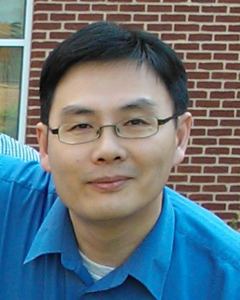Hui Li, PhD
Hui Li Lab
One of the central paradigms is that genes are located in isolated zones, minding their own business (making their own RNAs and proteins) and don’t usually cross talk with each other, except in pathological situations. For example, one of the hallmarks in cancer is DNA rearrangement, which results in the fusion of two separate genes. These gene fusion products often play critical roles in cancer development. Traditionally, they are thought to be the sole product of DNA rearrangement and therefore unique to cancer. This belief forms the basis for many cancer diagnostic and therapeutic approaches. Recently, we discovered two mechanisms that could generate fusion products without DNA rearrangement. One of the process is called “RNA trans-splicing”, whereby two separate RNAs can be spliced together and generate a fusion RNA, which then can be translated into a fusion protein. The other process involves two neighboring genes transcribing in the same direction, “cis-Splicing of Adjacent Genes (cis-SAGe). Our work on RNA trans-splicing and intergenic cis-splicing have posed a challenge to the traditional views and helped open a new paradigm for intergenic splicing processes that generate gene products in normal physiological conditions: even in the absence of physically “touching” each other, genes do send messages (messenger RNA) that can be mingled together.
RNAs and proteins) and don’t usually cross talk with each other, except in pathological situations. For example, one of the hallmarks in cancer is DNA rearrangement, which results in the fusion of two separate genes. These gene fusion products often play critical roles in cancer development. Traditionally, they are thought to be the sole product of DNA rearrangement and therefore unique to cancer. This belief forms the basis for many cancer diagnostic and therapeutic approaches. Recently, we discovered two mechanisms that could generate fusion products without DNA rearrangement. One of the process is called “RNA trans-splicing”, whereby two separate RNAs can be spliced together and generate a fusion RNA, which then can be translated into a fusion protein. The other process involves two neighboring genes transcribing in the same direction, “cis-Splicing of Adjacent Genes (cis-SAGe). Our work on RNA trans-splicing and intergenic cis-splicing have posed a challenge to the traditional views and helped open a new paradigm for intergenic splicing processes that generate gene products in normal physiological conditions: even in the absence of physically “touching” each other, genes do send messages (messenger RNA) that can be mingled together.
Our long-term goals are to understand the scope of these phenomena, the physiological functions of these “intergenic splicing” process and their implications in both normal development and in cancer.
Other focuses of the lab are finding oncogene addiction events in glioblastoma (GBM), pediatric cancer, and breast cancer, developing novel drugs with minimal side effects. Recently, we have discovered a new cancer-driving gene, AVIL. AVIL gene is highly expressed in all the GBMs, but hardly detectable in non-cancer control cells and tissues. We have accumulated strong preliminary data supporting the premises that AVIL is an Achilles heel of GBMs, to which glioblastoma cells are addicted: AVIL is not only needed for GBM cells to survive and for tumor to develop in animal xenograft models, its expression is also correlated with patient survival. I Studies of the mechanism and its oncogenic effect will not only help us better understand the disease, but also lead to better treatment options.
